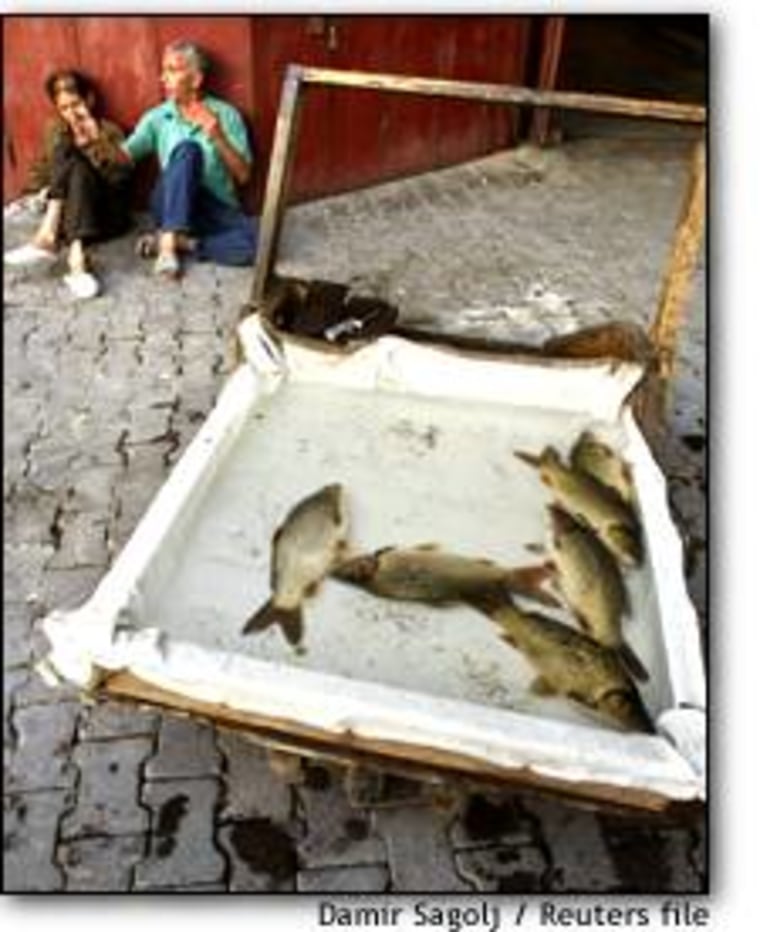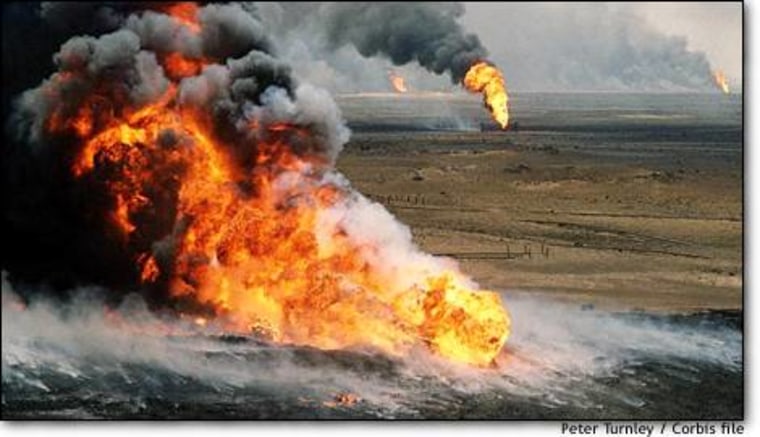Matthew Naud didn’t know what to expect when he flew into Kuwait in 1991 as hundreds of its oil wells burned, set ablaze by Iraqi troops as they retreated during the Gulf War. What the environmental consultant found was a man-made hell on Earth. Now, as the prospect of another war grows, Naud and other experts fear even deeper health and environmental damage may result this time.
Driving into Kuwait City “you began to see the smoke — pitch black for most of the wells, white from a few others — all rising and mingling to form one large plume,” he recalled. “The most striking feature was the noise and the wind — the power of the fire at each well roaring like a jet engine and the heat from the fires creating their own weather, very surreal.”
“People talk about a paradigm shift, and this was one — a physical and visual sensation unlike any other and outside any expectation or previous experience,” added Naud, who was a private consultant with the Environmental Protection Agency team that advised Kuwait on its cleanup.
The subtle stuff
The fires were extinguished faster than expected. But Kuwait would not go unscathed.

Health studies are still being undertaken to track any long-term effects on Kuwaitis of the cancer-causing soot. Groundwater is threatened where oil lakes have formed near the destroyed fields. Cormorant populations in the Persian Gulf fell sharply after Iraq released some 200 million gallons of Kuwaiti oil into the gulf — the largest oil spill ever. Trenches and berms built in the sand altered nature, leading to a huge increase in the formation of dunes after the war.
Naud himself was part of a Green Cross International team that went to Kuwait seven years after the war to report on the environmental fallout.
The soot and oil lakes caused by destroyed oil wells, the team reported, “represent a major long-term public health issue because they potentially affect the whole population of Kuwait.”
Naud worries that war would cause even greater impact in Iraq because of its more varied geography and its reliance on two large rivers, the Euphrates and Tigris.
If oil or chemicals spilled into a river, he noted, the impact “would have a much more significant effect” than a desert spill. “I don’t know that a river would recover as quickly as the desert.”
On top of that, anything that spills into the Euphrates or Tigris “is going to end up in the gulf,” Naud said, where currents and shallow waters would spread the pollution.
Damage from both sides
Given what happened in Kuwait, might Iraqi President Saddam Hussein destroy Iraq’s own oil fields if he felt he were about to lose a war?
U.S. intelligence officials have told reporters they have solid evidence that Saddam is planning just that — along with destroying Iraqi infrastructure — as a way to blame the United States for a humanitarian crisis.
Those officials also believe Saddam would use biological and chemical weapons if he were about to fall and that his primary targets would be U.S. troops, Kuwaitis and Israelis.
Health activists note that Saddam’s actions are just part of the equation, that the how and what of any U.S.-led bombing also would leave long-term impacts, especially since the region is still recovering from the 1991 war and because most Iraqis are dependent on aid for subsistence.
A U.N. contingency plan estimates that a U.S.-led attack would cause shortages of clean water and sanitation, placing 10 million Iraqi civilians at risk of hunger and disease in “epidemic if not pandemic proportions.” The plan expects millions to flee Baghdad and central Iraq for the south, and possibly neighboring Iran.
This scenario played out on a smaller scale during the Gulf War. Declassified documents show that U.S. troops contributed to the infrastructure damage, destroying some power plants and water storage and treatment facilities and possibly contributing to the spread of diseases such as measles, diarrhea, typhoid and cholera through the population of 1.8 million refugees. By May 1991 some 15,000 to 30,000 had died, according to the United Nations.
The British physicians group Medact is among those who fear that a war for Iraq would lead to even greater human and environmental casualties than during the Gulf War. In a report last November, Medact posed these scenarios:
Airstrikes: U.S.-led bombing hits Iraqi weapons stockpiles, releasing chemical, biological and possibly radioactive pollutants. Health and water infrastructure is also hit, leading to epidemic diseases.
Securing the oil. U.S. troops invade to secure the oil fields around Basra near the Persian Gulf. Combat in urban areas leads to heavy loss of life, while sabotage of oil wells spills crude and endangers health.
Securing the north: U.S. troops invade Iraqi Kurdistan, Iraq responds with chemical and/or biological weapons. Sabotage of oil wells spills crude and endangers health.
Battle for Baghdad: Airstrikes and ground combat in urban areas lead to heavy losses.
Saddam’s last stand: Chemical and biological weapons are used in and around Iraq or against Israel. Israel, the United States or Britain could respond with a nuclear strike. A Hiroshima-sized bomb — a relatively small weapon by modern measurements — could kill 66,000 to 360,000 if dropped on Baghdad. A large thermonuclear weapon could kill 306,000 to 3.6 million.
Call for broader debate
Medact said it agrees with Western leaders that Saddam’s regime is dangerous, but it argued that a decision to go to war requires a broader discussion. “The true cost of war,” the group stated, “must be calculated and widely debated.”
Environmentalists argue that such a debate needs to include the long-term environmental impacts of war.
“Ultimately, security and stability in Iraq will depend more on the long-term impact of war and its aftermath on people than on the short-term military outcome,” said Jonathan Lash, director of the World Resources Institute. “And over the decades, the environmental consequences of armed conflict will loom large. For that reason, they must be part of the strategy.”
Naud, for his part, feels it’s “somewhat simplistic to even discuss potential environmental effects when the potential human effects are so daunting.”
But he, like others, fears scenarios far worse than Kuwait’s oil fields on fire.
“A replay of that scenario does not scare me,” Naud said, noting that experts would be able to at least apply what they learned in Kuwait. “It’s the new scenarios that we haven’t seen, whether planned or accidental, that concern me.”
